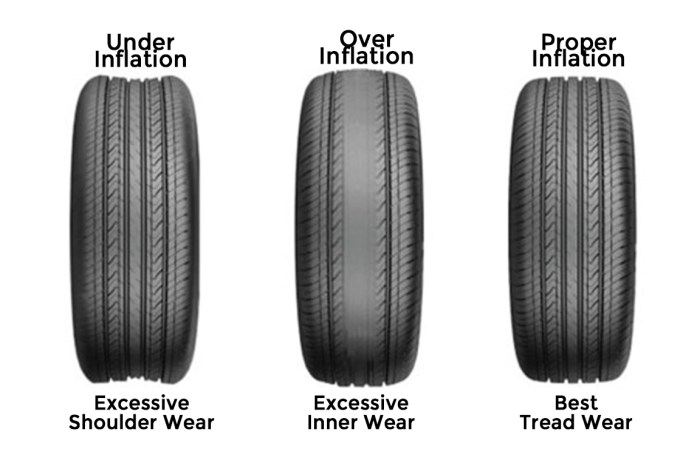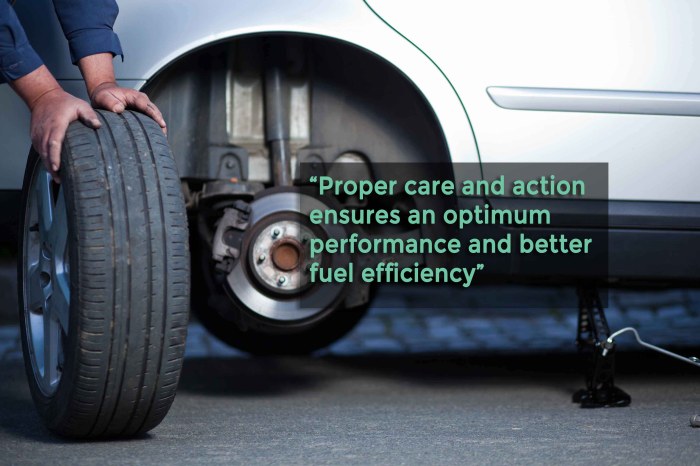Guide to car tire maintenance takes center stage as we delve into the importance of regular maintenance to ensure safety and performance. From tire pressure checks to tread depth inspections, this guide covers it all to keep your vehicle running smoothly.
Importance of Car Tire Maintenance: Guide To Car Tire Maintenance
Regular tire maintenance is crucial for ensuring the safety and performance of your vehicle. By properly caring for your tires, you can extend their lifespan and improve fuel efficiency, ultimately saving you money in the long run.
Extended Lifespan of Tires, Guide to car tire maintenance
Proper tire maintenance, such as regular tire rotations and alignments, can help prevent uneven wear and tear on your tires. This can significantly extend the lifespan of your tires, allowing you to get more mileage out of them before needing to replace them.
Improved Fuel Efficiency
Under-inflated tires can lead to increased rolling resistance, causing your vehicle to consume more fuel to maintain speed. By regularly checking and maintaining the correct tire pressure, you can improve fuel efficiency and save money on gas expenses.
Risks of Neglecting Tire Maintenance
Neglecting tire maintenance can pose serious risks to your safety on the road. Over or under-inflated tires, worn-out treads, or misaligned wheels can increase the likelihood of accidents, especially in wet or slippery conditions. Additionally, failing to address tire issues promptly can result in costly repairs or replacements down the line.
Tire Pressure Check
Maintaining the correct tire pressure is crucial for the safety and performance of your vehicle. Improper tire pressure can lead to decreased fuel efficiency, uneven tire wear, poor handling, and even tire blowouts. Regularly checking your tire pressure is a simple yet important task that should not be overlooked.
Importance of Maintaining Correct Tire Pressure
- Proper tire pressure ensures optimal fuel efficiency, saving you money in the long run.
- Correct tire pressure promotes even tire wear, extending the life of your tires.
- Underinflated tires can overheat and lead to tire failure, putting you at risk of accidents.
- Overinflated tires can reduce traction and handling, especially in wet or slippery conditions.
How to Check Tire Pressure Using a Pressure Gauge
Follow these steps to accurately check your tire pressure:
- Locate the recommended tire pressure for your vehicle (usually found on a sticker inside the driver’s side door or in the owner’s manual).
- Remove the valve cap from the tire valve stem.
- Press the pressure gauge onto the valve stem to get a reading. Repeat this process for all four tires.
- If the pressure is low, use an air compressor to inflate the tire to the recommended level. If it’s high, release some air by pressing the center pin in the valve.
- Replace the valve cap and recheck the pressure to ensure it’s within the recommended range.
Consequences of Underinflated or Overinflated Tires
Both underinflated and overinflated tires can have negative effects on your vehicle:
-
Underinflated Tires
can lead to increased rolling resistance, reduced fuel efficiency, uneven tire wear, and a higher risk of blowouts.
-
Overinflated Tires
can cause a harsh ride, decreased traction, uneven wear in the center of the tire, and potential damage to the suspension components.
Tire Tread Depth Inspection

Checking tire tread depth is crucial for safety on the road. Adequate tread depth helps maintain traction, especially in wet or slippery conditions, reducing the risk of skidding or hydroplaning. Insufficient tread depth can lead to decreased handling and longer braking distances, putting you and others in danger.
Methods to Measure Tire Tread Depth
- Using a Tread Depth Gauge: This tool provides an accurate measurement of the tread depth in millimeters or inches, allowing you to track the wear of your tires effectively.
- The Penny Test: Insert a penny into the tread grooves with Lincoln’s head facing down. If you can see the top of Lincoln’s head, your tread depth is too low, indicating the need for replacement.
Legal Requirements and Tire Replacement
- Legal Minimum Tread Depth: In most places, the legal minimum tread depth is 2/32 of an inch. However, it is recommended to replace tires before reaching this limit for optimal safety.
- When to Replace Tires: Apart from reaching the legal limit, consider replacing tires when the tread depth is 4/32 of an inch or less for improved traction and performance.
Tire Rotation and Wheel Alignment
Regular tire rotation and wheel alignment are essential for maintaining the optimal performance and longevity of your vehicle’s tires. By following proper rotation schedules and ensuring correct wheel alignment, you can prevent uneven wear, improve fuel efficiency, and enhance overall driving safety.
Tire Rotation
Tire rotation involves moving each tire to a different position on the vehicle to ensure even wear. This practice helps extend the lifespan of your tires and promotes better traction and handling. It is recommended to rotate your tires every 6,000 to 8,000 miles or as advised by your vehicle manufacturer. For front-wheel drive vehicles, the front tires should be moved to the back and vice versa. In the case of rear-wheel or all-wheel drive vehicles, the pattern may vary, so refer to your owner’s manual for specific instructions.
Wheel Alignment
Proper wheel alignment ensures that your vehicle’s wheels are angled correctly, allowing them to make optimal contact with the road surface. Misaligned wheels can lead to uneven tire wear, decreased fuel efficiency, and poor vehicle handling. It is essential to have your wheel alignment checked annually or if you notice symptoms such as uneven tire wear, steering wheel vibration, or pulling to one side. A professional alignment service can adjust the angles of the wheels to the manufacturer’s specifications, ensuring a smooth and safe driving experience.
Final Review

By following the tips and guidelines Artikeld in this maintenance guide, you can be sure to keep your car tires in top condition, enhancing both safety and performance on the road. Stay informed, stay safe!
When it comes to keeping your car in top shape, rust prevention is key. Check out these car rust prevention methods to ensure your vehicle stays looking great for years to come. Additionally, using the top car detailing products can help maintain your car’s appearance and prevent rust from forming.
When it comes to keeping your car in top condition, rust prevention is key. There are various car rust prevention methods you can use to protect your vehicle from corrosion and extend its lifespan. From regular washes to applying protective coatings, these techniques can help maintain your car’s appearance and value.
For those who are passionate about maintaining their car’s aesthetics, using the top car detailing products is essential. From premium waxes to high-quality microfiber towels, these products can help you achieve a professional-level finish and keep your car looking pristine.
Invest in quality detailing products to make your car stand out on the road.